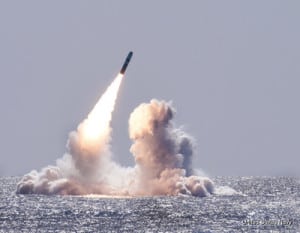The Defense Department plans to use the proposed Mk 7 W93 submarine-launched nuclear ballistic missile (SLBM) warhead to eventually replace the current W76 and W88 warheads without increasing the size of the nuclear stockpile, according to a Department of Defense senior official.
The U.S. currently uses the W76 and W88 families of warheads on the Trident II D5 SLBMs based on Ohio-class ballistic missile submarines.

“Both of these systems are growing old and so now we must start thinking about a warhead that will replace one of those two when it’s time for those systems to retire. And these things take a long time. There’s a seven-phase process by which we start to develop a warhead,” the official said on Friday.
The official noted the W93 will likely replace the W88 before the W76.
As part of this effort, the Defense Department will be getting a new program of record for the W93 to go on the SLBM. The work is starting now “now so that in the next 15 to 20 years we have a warhead that’s available to replace the aging W88.”
The official underscored it will “be based on previous designs, previously nuclear tested designs. It’s not going to require any nuclear testing and, in fact, it’s not even going to increase the size of the nuclear stockpile because as we start to field, eventually the W93s, the 88s will probably come out of the inventory.”
“The idea and current plan is to one-for-one almost replace weapons in the current triad with W93s, so no appreciable increase in the size of the strategic stockpile,” the official continued.
Given the 15-20-year timeline and expected life of the current warheads, the W93 would likely be used on the Columbia-class SLBM submarine, which is succeeding the current Ohio-class. The first of 12 Columbias is planned to go on its first patrol in 2031 and the vessels are expected to serve through the 2080s.
The official noted this planning goes back to the Obama administration, which was considering replacement warheads for the land-based intercontinental ballistic missile and SLBM, which it called Interoperable Warhead 1 and 2, IW-1 and IW-2.
The W93 will be the first new warhead design since the Cold War that is not a refurbished model of a currently deployed weapon.
The Department of Energy’s National Nuclear Security Administration (NNSA) is currently refurbishing the W88 as the W88 Alt-370 to extend its service life for decades longer by refurbishing its conventional high explosives and other detonation system components. NNSA plans to manufacture the first W88 Alt-370 in 2021 (Defense Daily, Feb. 11).
NNSA already finished refurbishing the W76 into the W76-1 in late 2018, allowing it to operate for decades longer (Defense Daily, Jan. 23, 2019).
Defense Daily previously reported the W93 is being designed to be rapidly upgradeable and serviced outside of the Department of Energy’s Pantex Plant in Amarillo, Texas.
The NNSA FY 2020 stockpile Stewardship and Management Plan said the notional first production date for W93 was in 2034 with early feasibility studies starting this year. The NNSA also estimated its portion of the W93 work will cost about $14 billion under that plan (Defense Daily, Feb. 11).
The Energy Department is asking for $53 million in its FY 2021 budget request for the W93, seeking funds two years earlier than the FY 2020 budget request planned. This early W93 work may include research and development efforts like fuses and aero shells, Adm Charles Richard, commander of U.S Strategic Command, said in congressional testimony last week (Defense Daily, Feb. 20)